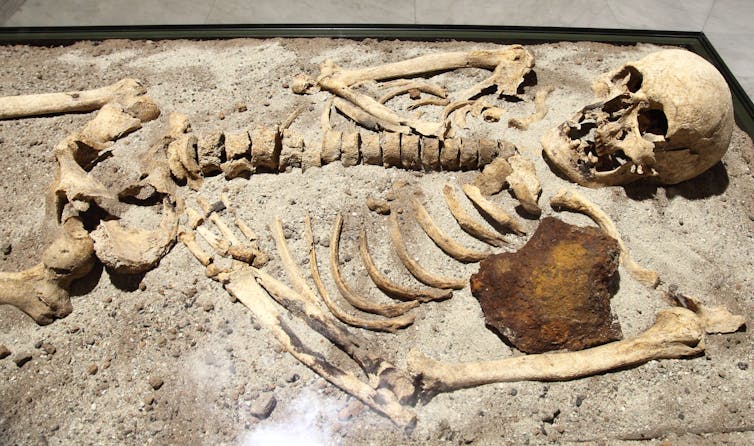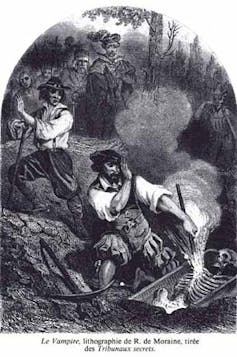How long have we believed in vampires?

EMVDS-photography/Shutterstock.com
Sam George, University of Hertfordshire
Vampires have a contested history. Some claim that the creatures are “as old as the world”. But more recent arguments suggest that our belief in vampires and the undead was born in the 18th century, when the first European accounts appear.
We do know that 1732 was the vampire’s annus mirabilis. There were 12 books and four dissertations on the subject published over that year, as well as the term’s first appearance in the English language, according to gothic expert Roger Luckhurst. But archaeological discoveries of deviant burials in Europe in the last few years have unearthed a belief in vampirism and revenants before 1500, much earlier than was previously understood by literary scholars.
The body of a 500-year-old “vampire”, for example, is currently on display in an ancient cemetery in the town of Kamien Pomorski, Poland. The vampire corpse, discovered two years ago, has been reported on widely in the world’s press. Archaeologists have confirmed that it has a stake through its leg (presumably to prevent it from leaving its coffin) and a rock in its mouth (to stop any unfinished blood sucking). Even older deviant burials have been discovered in villages in Bulgaria.

Bin im Garten, CC BY-SA
Meanwhile, the medieval remains of the first English vampires in Yorkshire’s village of Wharram Percy have reputedly been found. The inhabitants who fled the village in 1500 showed widespread belief in the undead returning as revenants or reanimated corpses. They fought back against the risk of vampire attacks and showed a medieval belief in an English zombie apocalypse, an episode that would not be out of place in a scene from The Walking Dead.
So some form of vampire was evidently believed in throughout much of Europe from the medieval period. But the seductive Romantic vampire does not leave his calling card in polite society in London until 1819, when the first fictional vampire, the satanic Lord Ruthven is born in a story by John Polidori. So how did our understanding of vampires transition from dishevelled peasants into alluring Byronic aristocrats? We must return the creature to its beginnings in early folk belief to fully understand its history.
Vampire, vrykolakoi, velku
In the first written accounts of European vampires, the creatures are understood as revenants or returners, often taking the form of a diseased family member who reappears in the unfortunate guise of a vampire. In such tales, “unfinished business”, even something as trivial as the want of clothing or shoes, is enough to make the dead return to the world of the living.
The number of words for “vampire” can frustrate scholars: Krvoijac, vukodlak, wilkolak, varcolac, vurvolak, liderc nadaly, liougat, kullkutha, moroii, strigoi, murony, streghoi, vrykolakoi, upir, dschuma, velku, dlaka, nachzehrer, zaloznye, nosferatu … the list goes on.
The Oxford English Dictionary takes seven pages to define a vampire, but the earliest entry, of 1734, is of most interest here:
These Vampyres are supposed to be the Bodies of deceased Persons, animated by evil Spirits, which come out of the Graves in the Night-time, suck the Blood of many of the Living and thereby destroy them.

Wikimedia Commons
There is evidently little appeal or attraction felt for these early revenant figures. Unlike the English aristocratic vampire, modelled on Lord Byron, these early folkloric vampires are peasants and tend to appear en mass like modern-day zombies.
Agnes Murgoci explored this folk belief further. She argued in 1926 that the journey from death to the afterlife is perilous – in Romanian belief it took 40 days for the soul of the deceased to enter paradise. In some cases, it was thought that it lingered for years, and during this time there are a myriad of ways that deceased family members can succumb to vampirism.
It was thought that dying unmarried, unforgiven by one’s parents, through suicide or being murdered could all lead to a person returning as a vampire. Events after death could also have the same effect – beware breezes blowing across corpses before burial, dogs or cats walking over coffins, or leaving a mirror (a soul trap) not turned to the wall at this precarious time.
Entering literary spheres
It was a treatise written in 1746 by the French monk Antoine Augustin Calmet that famously gave British writers access to a number of encounters with vampires. Calmet took inspiration from Joseph Pitton de Tournefort, a botanising man of science, who had earlier claimed to have come face to face with a plague of bloodsucking vampires in Mykonos in 1702. His account was still being read in 1741.
Three decades after Tournefort’s encounter, the London Journal of 1732 reported some enquiries into “vampyres” at Madreyga in Hungary (a story later referred to by John Polidori). Greece and Hungary feature prominently in these early accounts – and this is mirrored in Romantic literature: Lord Byron for example makes Greece the setting of his unfinished vampire story A Fragment (1819).
But it was Polidori who was responsible for the vampire’s English pedigree and its elevation of social rank. There seems never to have been an urban, nor an educated bourgeois bloodsucker prior to The Vampyre (1819). A predatory sexuality is also introduced. We see for the first time the vampire as rake or libertine, a real “lady killer” – a trend that metamorphosed into Bram Stoker’s Dracula and anticipated the arrival of vampire romance in the beautiful undead form of Twilight’s Edward Cullen.
As this all reveals, the history of vampires is a disputed and uncertain one whatever your perspective, scientific or literary. But the “vampire” burials discovered by archaeologists of late do cohere with practices that are known to suggest a belief in vampirism (such as piercing the corpse, nailing down the tongue, putting a needle in the heart and placing small stones and incense in the mouth and under the finger nails to stop blood sucking and clawing). These “vampire” corpses do therefore go some way towards finding out how old our belief in vampires actually is.
![]() But the history of vampires is still impossible to chart with any certainty, and we should probably take heed from British vampirologist Montague Summers (1880-1948) in our search for the lair of the original fiend. He referred to vampires as “citizens of the world”: to him, they existed beyond temporal or geographical boundaries.
But the history of vampires is still impossible to chart with any certainty, and we should probably take heed from British vampirologist Montague Summers (1880-1948) in our search for the lair of the original fiend. He referred to vampires as “citizens of the world”: to him, they existed beyond temporal or geographical boundaries.
Sam George, Senior Lecturer in Literature, University of Hertfordshire
This article was originally published on The Conversation. Read the original article.
